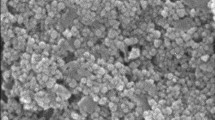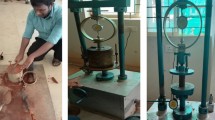Abstract
Soil stabilization is a technique to improve the weak soils and making them to meet certain requirements of the specific engineering projects. The type of soils available in Dakshina Kannada region of Karnataka State is laterite and Lithomarge clay. Its Plasticity Index is very high due to the presence of high percentage of silt and clay content. In the present investigation, an attempt is made to study the behaviour of laterite with and without adding chemicals. A chemical named Zycosoil, when added to water and mixed with soil alters its engineering properties that depend upon the type of the soil and dosage of chemical. These chemicals are liquid additives, which act on the soil to reduce the voids between soil particles and minimize adsorbed water in the soil for maximum compaction. In the present study, the effectiveness of Zycosoil in stabilizing the laterite soils of South Canara district is investigated through laboratory experiments. Various geotechnical properties are studied and correlations between different geotechnical properties and improvement in the soil properties with different percentages of chemical additions are derived. The important properties such as index properties, compaction characteristics, unconfined compressive strength parameters, California bearing ratio values and fatigue behaviour were studied. The results obtained indicate that there is an improvement in almost all properties with the addition of Zycosoil.



Similar content being viewed by others
References
Aydogmus T, Alexiew D, Klapperich H (2004) Investigation of interaction behaviour of cement-stabilized cohesive soil and PVA geogrids. Geotechnical engineering with geosynthetics, Proceedings of the third European Geosynthetics Conference, Munich, Germany. p 3
Hashim EAB, Mahmud HB, Muntohar AS (2005) Stabilization of residual soil with rice husk ash and cement. J Constr Build Mater 14:448–453
Indian Standard: 1498–1970, Classification and identification of soil for general engineering purposes, Bureau of Indian Standards, New Delhi
Indian Standard: 2720 Methods of tests for soils (Part 2)—1973, determination of water content of soil, Bureau of Indian Standards, New Delhi
Indian Standard: 2720 Methods of tests for soils (Part 3)—1980, determination of specific gravity of soil, Bureau of Indian Standards, New Delhi
Indian Standard: 2720 Methods of tests for soils (Part 4)—1985. Specification for grain size analysis, Bureau of Indian Standards, New Delhi
Indian Standard: 2720 Methods of tests for soils (Part5)—1985, determination of liquid & plastic limit of soil, Bureau of Indian Standards, New Delhi
Indian Standard: 2720 Methods of tests for soils (Part 7)—1980, determination of water content—dry density relation of soil using light compaction, Bureau of Indian Standards, New Delhi
Indian Standard: 2720 Methods of tests for soils (Part 8)—1983, determination of water content, dry density relation of soil using heavy compaction (second revision), Bureau of Indian Standards, New Delhi
Indian Standard: 2720 Methods of tests for soils (Part 10)—1973, determination of unconfined compressive strength of soil, Bureau of Indian Standards, New Delhi
Indian Standard: 2720 Methods of tests for soils (Part 16)—1987, laboratory determination of C.B.R of soil (second revision), Bureau of Indian Standards, New Delhi.
Indian Standard: 2720 Methods of tests for soils (Part 17)—1986, determination of permeability of soil, Bureau of Indian Standards, New Delhi
IRC: SP: 72-2007, Guidelines for the design of flexible pavements for low volume rural roads, The Indian Roads Congress, New Delhi
Miller GA, Azad S (2000) Influence of soil type on stabilization with cement kiln dust. J Constr Build Mater 14:89–97
Ravi Shankar AU, Suresha SN, Kashinath B (2008) Characterisation of lateritic soil modified with pond ash and cement. Journal of Indian Highways 2008:21–27
Sadek D, Roslan H, Abubakar Alwi (2008) Engineering properties of stabilized tropical peat soils. vol 13, Bund. EJGE, pp 7–8
Santoni RL, Tingle JS, Webster SL (2001) Non-traditional stabilization of silty sand. Technical Report, U.S. Army Engineering Research and Development Centre, Waterways Experiment Station, Vicksburg, MS
Syed IM, Fuselier GK, Hewitt M (2007) Innovation in cement stabilization of airfield subgrades. FAA Worldwide Airport Technology Conference, New Jersey
Yang HH (2004) Pavement analysis and design, 2nd edn. Pearson Prentice Hall, New Jersey, pp 677–681
Author information
Authors and Affiliations
Corresponding author
Appendix
Appendix
Chemical Dosage
The chemical used for the soil is diluted in water at 1:100 concentrations and then mixed with soil in different dosages. The calculations for UCS test sample preparation are shown in Tables 10 and 11.
Rights and permissions
About this article
Cite this article
Lekha, B.M., Ravi Shankar, A.U. & Sarang, G. Fatigue and Engineering Properties of Chemically Stabilized Soil for Pavements. Indian Geotech J 43, 96–104 (2013). https://doi.org/10.1007/s40098-012-0031-5
Received:
Accepted:
Published:
Issue Date:
DOI: https://doi.org/10.1007/s40098-012-0031-5




